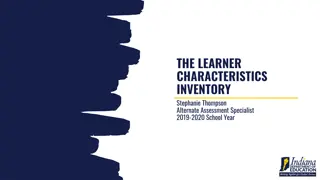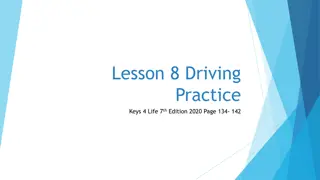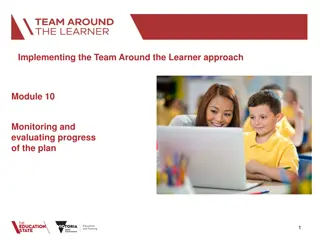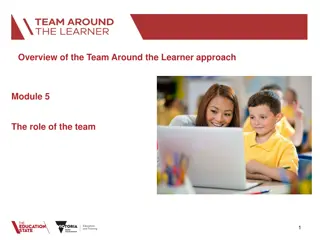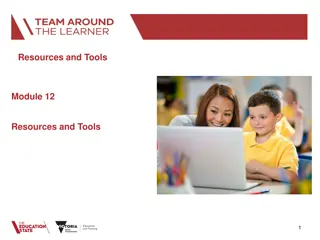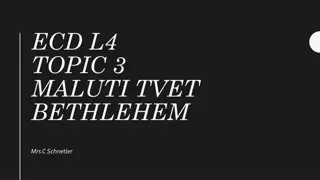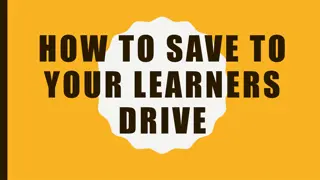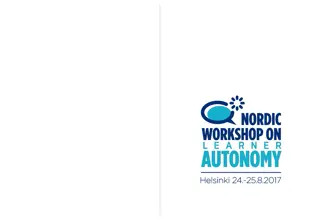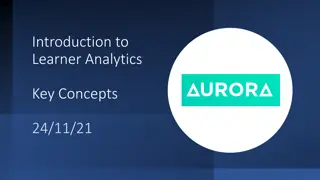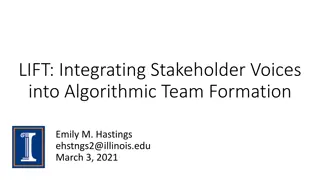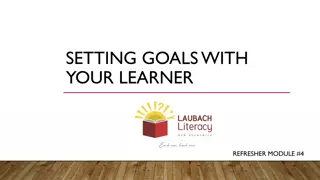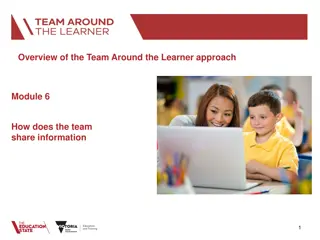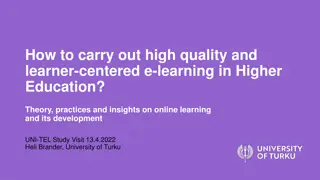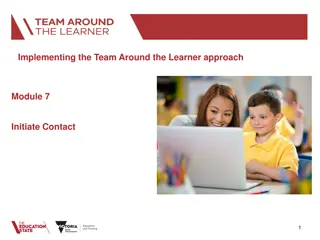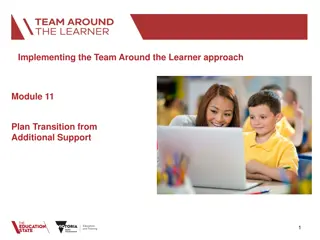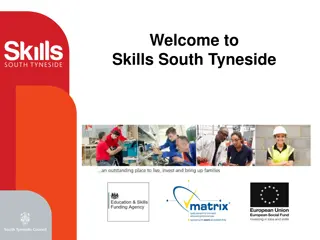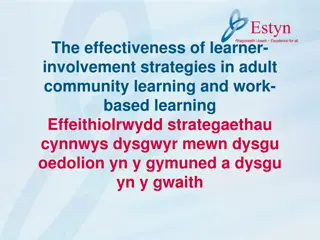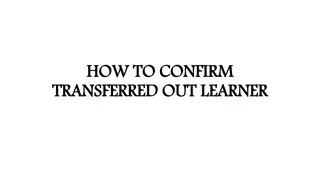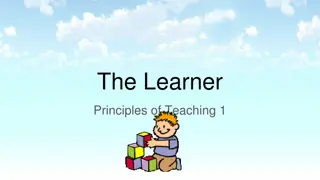Overview of Team Around the Learner Approach
The roles and responsibilities of individuals in the Team Around the Learner approach. Learn who is involved, why they are involved, and how they work together to support the learner.
- roles and responsibilities
- key team members
- learner
- family
- lead professional
- collaboration
- education
- support
Uploaded on Dec 23, 2023 | 2 Views
Download Presentation

Please find below an Image/Link to download the presentation.
The content on the website is provided AS IS for your information and personal use only. It may not be sold, licensed, or shared on other websites without obtaining consent from the author. Download presentation by click this link. If you encounter any issues during the download, it is possible that the publisher has removed the file from their server.
E N D
Presentation Transcript
Overview of the Team Around the Learner approach Module 3 Who is in the team? 1
Module 3: Who is in the Team? Overview The aim of this module is to understand in detail the roles and responsibilities of the individuals participating in the Team Around the Learner approach. This module will outline who is involved in the process, why they are involved, and how. Key to the Team Around the Learner approach is the role of the Lead Professional, which will be clarified in the following module in greater detail. Focus This module will support your understanding of: 3 Who is in the team? Understanding the roles and responsibilities of key team members Roles and responsibilities during the Team Around the Learner approach 2
Understanding the roles and responsibilities of key team members Teamwork is the cornerstone of the Team Around the Learner approach Teamwork is the reason why this approach works in meeting the needs of the learner and sustaining them in education. The team is brought together and considers the needs of the learner within education and the factors impacting on their engagement in education. The team purposefully collaborates and connects together through the Team Around the Learner approach. The entire team as part of Team Around the Learner consists of several roles: Initial Contact Person School Learner Lead professional Family Team 3
Understanding the roles and responsibilities of key team members Learner The learner is the motivation for the Team Around the Learner approach and is at the centre of service planning. Who can be a learner? Learners are children or young people who engage in learning programs and who are vulnerable or at risk of vulnerability, or who have additional or complex needs. They require or are accessing multiple services that need to be coordinated. What is their role? The expectation is that learners will fully engages and participate in the process. To enable this, learners may need to be empowered to express needs, goals, issues of concerns as they arise. The likelihood of successful outcomes are increased when the perspectives of the learners are addressed. Learner are central to the team, are actively consulted and provided with opportunities to express their needs during the process so that their voice and perspective drive the process. This also recognises that there are limits to consider, such as safety, age appropriateness, rules and policies etc. Learners may not always feel comfortable voicing their opinions. A conscious effort or specific strategies may be required to ensure learners feels safe and in a place where they will be heard and not judged. 4
Understanding the roles and responsibilities of key team members Team Around the Learner is a person centred and family sensitive practice approach concerned with responding to the learner's needs within the context of education. Family Who can be considered family? It is important or understand the context of the learner s family situation and whether it is appropriate for them to be involved. Safety and wellbeing concerns may limit their involvement in Team Around the Learner. Family may include: biological or adoptive parents grandparents/kin and or other extended family court assigned custody to a public agency a community member or significant adult in the life of the learner What is their role? The role of the family is to : provide the family s perspective to other team members assist in encouraging the learner's strengths and needs participate in supporting the goals for achieving the learner's needs provide input into the development and implementation of strategies and actions to achieve goals be part of the support network for the learner moving through the Team Around the Learner journey 5
Understanding the roles and responsibilities of key team members The initial contact person is the learner's first point of contact. Who can be an initial contact person? The initial contact person may be anyone who cares for, supports or works with the learner. They must be able to recognise and articulate the need for a co-ordinated service and support approach to address the learner s vulnerability and complex needs. This recognition may have also come through as a suggestion for someone else. Most often the initial contact person is someone who has the appropriate knowledge and skills to begin the process. What is their role? Engage with the learner and family and begin the process of needs identification. Introduce the notion of team and support planning - clarify any questions. Identify the level of assistance required and capture information on the Initial Needs Identification tool. Initiate consent and information sharing processes. Initial contact person After the Initiate Contact phase the initial contact person's role will transition to either that of the Lead Professional or a team member as they are most likely someone who is working closely with the learner. 6
Understanding the roles and responsibilities of key team members The Lead Professional is the key coordinator the role creates and sustains a collaborative team environment around the learner. Who can be a Lead Professional? It will depend on where the need is first identified, and what the focus of the need is. It may change over time. This person could be the initial contact person or someone else who works with or is close to the learner. It is important that this person has a good relationship with the learner and is someone who is trusted and is capable of taking on the role within the team. In a learning setting or in learning re-engagement, it is most likely that the role would be taken on by an education professional (assistant principal, school staff member, wellbeing/welfare coordinator, Koorie workforce member etc.). However, when the focus of need is on health or child protection, the main coordinating role would lie with an external agency, with education professionals having a collaborative role to play in this broader team. The Lead Professional must be able to be the key contact point for coordination and communication with all members of the team. The Lead Professional must be able to establish a good working relationship with the learner and team to facilitate the process. The learner will be consulted about the role and function of the Lead Professional and discuss how they can best work together. When considering who is best placed to take on this role, the following should be considered: Decide who will be undertaking the most direct/therapeutic work with the learner. This person should not be the lead professional as they have a different role, capacity and relationship with the learner. Lead Profess ional 7
Understanding the roles and responsibilities of key team members The Lead Professional is the key coordinator the role creates and sustains a collaborative team environment around the learner. What is their role? The Lead Professional acts to coordinate the Team Around the Learner process to ensure outcomes are achieved and the learner experiences seamless service delivery. The Lead Professional can be from within education or from an external agency. The Lead Professional's role is to: act as a point of co-ordination for the learner and family and oversee the approach coordinate the collective efforts of the team facilitate the learner's access to the education environment though active engagement and connection to the Team Around the Learner approach ensure ongoing engagement of other team members ensure the needs and goals of the learner are central to the planning process monitor the delivery of actions agreed by the team reduce overlap and inconsistency Lead profess ional The individual nominated to be the Lead Professional has the choice to decline the position where it is believed he/she cannot fulfil the role, there is a conflict of interest or for other professional reasons. The person in this role may also change over time, depending on commitments, conflict of interest or what the team thinks is working best. 8
Understanding the roles and responsibilities of key team members Teamwork underpins the Team Around the Learner approach to meet the needs of learners and sustains collaboration. Team Who can be a team member? Teams are made up of people who are connected to the learner through natural, community and formal support relationships. Examples of team members include the learner and family, education professionals, external community agencies, other government departments, relatives. Team members are identified with the learner, family and Lead Professional in the initial phases of the Team Around the Learner approach. Team members can be added at any point in time and where required. The team that forms the Team Around the Learner will vary in composition of the number involved and skills required. This will be dependent upon the level of service provision required to support the learner to remain engaged in education. The Lead Professional should ascertain each potential team member's willingness to participate and ensure their engagement in the collaborative process. 9
Understanding the roles and responsibilities of key team members Teamwork underpins the Team Around the Learner approach to meet the needs of learners and sustains collaboration. Team What is their role? Teams are brought together for the common purpose of improving outcomes for the learner. These individuals are most likely already working with the learner in some capacity and may have had their own plans. By working as a team and sharing information and ideas, teams are able to drive more effective discussion, decision making and initiatives that are more likely to be produce better outcomes for the learner. Working collaboratively and collectively on an agreed agenda is much more effective than working on individual or multiple agendas. Team members should: fully participate share ideas and collaborate with other team members respect the opinions of others uphold the Team Around the Learner key principles support the Lead Professional where required remain accountable for their actions work with families to help the learner engage in education be sensitive to the context of the family as it relates to the learner s ability to engage in education 10
Understanding the roles and responsibilities of key team members Team There are a number of roles that may make up the team in the Team Around the Learner approach. Who makes up the team will vary depending on the individual needs of the learner. In choosing the team it is useful to consider the following personnel and how they add value and expertise to the team to achieve the goals for the learner. Principal Principal: provides school leadership and an overview of the school context. Lead Advocate Professional Teacher: provides expertise and knowledge of the learning needs of the learner. Advocate: provides support to the learner and family and ensures the family voice is heard. Learner Support Professionals Health, Wellbeing & Inclusion staff: engage in collaboration and problem solving with schools to address barriers to learning Student Support Services, Nurses, Visiting Teachers, Koorie Engagement Support Officers. Family Community Agency: provides additional support to the learner and family and adds context to external issues impacting on the learner. Community Agency/LAECG Teacher Support Professionals: provides additional support to the learner and family and context to external issues impacting on the learner. SSS/KESO/VT/ NURSE 11
Roles and responsibilities during the Team Around the Learner Approach The following pages outline the responsibilities of the key roles in each phase of the Team Around the Learner approach. Phases of Team Around the Learner Plan & Coordinate Support Learner and family may invite / request Lead Professional to invite identified team members to Team Around the Learner meetings of the plan Communicate any issues or change of circumstances with the Lead Professional as soon as possible Voice any opinions or concerns Be part of the team Roles & Initiate Contact Analyse Needs Monitor & Evaluate Plan Transition Responsibilities Identify the Lead Professional Assess history and current needs Provide insights from past service provider strategies Actively participate in the development and implementation Keep the Lead Professional informed of progress against the goals, strategies and actions identified in the plan Provide honest and timely feedback to the Lead Professional Communicate to the team when goals have been achieved and sustained Celebrate successes Take on responsibility for own successes Keep in contact with the Team Around the Learner team and Lead Professional as required Learner & Family 12
Roles and responsibilities during the Team Around the Learner approach Phases of Team Around the Learner Roles & Plan & Coordinate Support Responsibilities Initiate Contact Analyse Needs Monitor & Evaluate Plan Transition Orient the learner and family to the Team Around the Learner process, answering any questions as they arise Introduce the concept of the Lead Professional Remain a member of the Team Around the Learner team as required Initial Contact Person becomes the Lead Professional or part of the Team Around the Learner team Initial Contact Person 13
Roles and responsibilities during the Team Around the Learner approach Phases of Team Around the Learner Plan & Coordinate Support Promote and encourage positive partnerships and a person centred, family sensitive approach Facilitate the development of the plan Confirm services and supports Document and disseminate the plan and any other information required Support learner and family and team to ensure that the plan is being implemented Establish formal and informal channels of communication Facilitate the development of a safety/crisis plan where required Educate others about Team Around the Learner Roles & Initiate Contact Analyse Needs Monitor & Evaluate Plan Transition Responsibilities Identify and engage team members Capture learner and family information Obtain informed written consent from learner and family around 'information sharing' Act as a single point of contact Develop meaningful relationships with the learner and family Educate the learner and family, team and others on the Team Around the Learner approach and principles Coordinate a comprehensive needs analysis and / or refer learner and family to qualified service providers as required Identify other services and supports that may be required and engage with them Brief other service providers on the Team Around the Learner process Organise Team Around the Learner meetings and invite team members Facilitate review meetings to look at achievements of goals and indicators of success Incorporate new strategies in the plan as required Celebrate success and recognise team strengths Maintain team cohesiveness, trust and buy-in Uphold the principles of the Team Around the Learner process Ensure that all documentation is completed, updated and distributed to team members Revisit previous phases of the Team Around the Learner approach if additional information is required or plans need to be amended Plan a purposeful transition away from formal supports Ensure that the family is continuing to experience success and provide support if necessary Celebrate successes and positively reinforce the skills and knowledge of the learner and family Follow-up with the learner and family periodically during the transition process Lead Professional 14
Roles and responsibilities during the Team Around the Learner approach Phases of Team Around the Learner Plan & Coordinate Support Participate in team activities as required Assist in conducting needs analysis where able and required Support the Lead Professional Work as part of a team, cooperating and communicating with others Uphold the principles of the Team Around the Learner process Attend meetings Roles & Initiate Contact Analyse Needs Monitor & Evaluate Plan Transition Responsibilities Be open to participating in the Team Around the Learner process as required Contribute to the development of plan Conduct roles and responsibilities as outlined in the plan Uphold roles and responsibilities Communicate the progress of actions and strategies with the Lead Professional and other Team members in a timely manner Continue to implement the plan Attend and participate in team meetings and activities Participate in the development of the Transition from Additional Support Plan Celebrate successes Continue to support the learner and family as required Team 15



